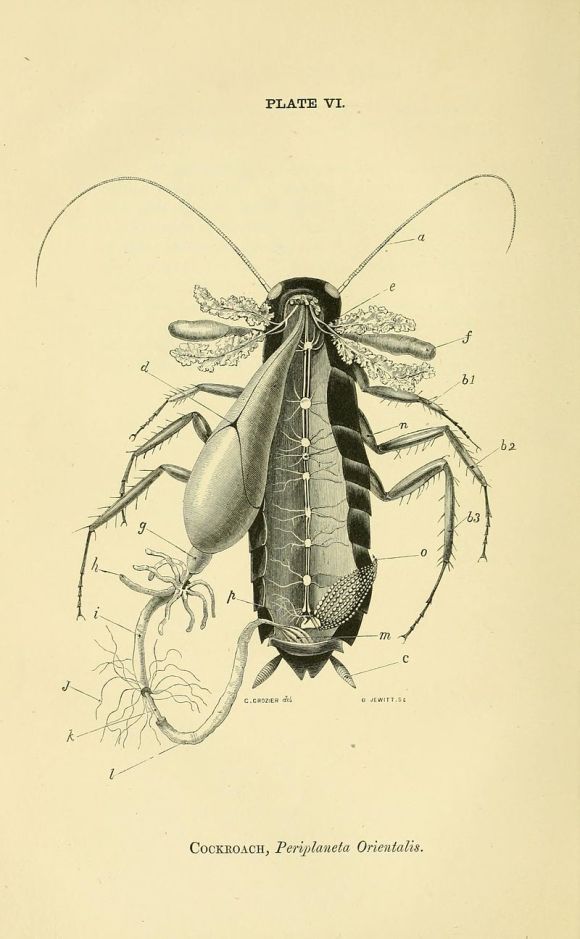
Ever wonder why cockroaches are so shiny? Well, let’s put our fears aside and learn a little more about one of the urban human’s greatest foes.
In July and August, the cockroach index is at its absolute peak across Japan. This means now is the time we are most likely to come head-to-head with those foul beasts, so perhaps we should take a moment to learn a little more about our sworn enemies.
It should be noted that there are many, many species of cockroaches in the world, some of which can be downright pretty. However, today we are dealing with the one’s that terrorize people’s homes and businesses: the German cockroach in particular.
As gruesome as that sounds, a cockroach’s digestive system is not that far removed for yours or mine. It’s just smaller and more streamlined — except in a few areas.
Roaches have some features similar to birds called a crop and a gizzard. A crop is like a reservoir to holds foods such as wood that take a little longer to digest. Right after that is the gizzard, which in birds contains special enzymes to break down food, but in the case of roaches has tiny teeth that grind it down further for easier eating.
▼ Cockroach’s Anatomy: crop is labelled “d” and gizzard is “g”
Sure, you could argue that those aren’t actually “teeth” in the strictest sense of the word, but let’s shelve the philosophical discussion of tooth existentialism for now and move on to the next bit of trivia.
This fact is so well traveled it makes you wonder if it’s actually just an urban legend, but yes, they can get by without a head. Despite having a brain, cockroaches can do alright without it. Much of their motor skills can be handled by clusters of nerve cells in other parts of their bodies. They breathe through the sides of their abdomen rather than their mouth, and they also have backup antennae on their body for sensing their environment.
However, despite having inner “teeth,” roaches are understandably terrible at eating or drinking without a head and as a result will eventually die of thirst first since a roach can survive up to 42 days on water alone.
Luckily, since cockroaches are way too fast for us to precisely decapitate them, this advantage rarely comes into play in most battles with people, but just how fast are they?
No, of course, not. They’re fast but if they were that fast there would be no way we could kill them… Don’t be silly.
However!
At full gait on level ground a roach can move its legs about 27 times per second. So, if we were to scale a cockroach to about the same size as a human, it could conceivably reach speeds of up to 320 kilometers per hour (199 miles per hour) and carry you to Tokyo a little faster than a bullet train… Can’t say it’d be quite as comfortable though.
Cockroaches are probably the least picky eaters on the planet and will pretty much consume anything they can get their mandibles on, including but not limited to dandruff, hair, wood, paper, grease, dead insects, and fabrics. However, in studies by Japan’s leading cockroach researcher Noboru Aoki, they would not eat salt nor soy sauce.
More for me I guess…
You might think it’s their low-sodium, high-exercise lifestyle that keeps all cockroaches in the same shape, but actually these bugs do have different fat percentages from each other. Unlike humans, who store fat throughout various body parts such as butts and man-boobs, roaches keep it all inside an organ called a “fat body.” This means that the chocolate they nip from your pantry will never go straight to their thighs – as if you needed another reason to hate them.
Aside from our psychological loathing of cockroaches, these creatures wallow in filth and spread bacteria everywhere they go, giving us a real reason to want them as far away as possible.
So, when encountering one you can’t help but notice their glossy appearance, which seems to be a physical manifestation of their pure grossness.
However, it is actually the roach’s natural defense to its own slovenly lifestyle. That glistening oil covering its body contains protective antimicrobial substances and also helps it retain water for those rare instances when it loses its head.
With so many strengths you might think being a cockroach is a sweet life. However, they do have their share of worries. As scavengers, roaches are hardly the top of the food chain. Certain species of wasps will inject them with eggs leaving them alive long enough for the offspring to burst through their bodies. Never a nice way to go.
And of course there are large spiders and house centipedes that’ll eat cockroaches in short order. Of course, unless you want a home filled with wasps, huge spiders, and/or centipedes, this doesn’t help people much.
I did once see a stray cat take out a cockroach on the street such with such extreme prejudice that I caught myself doing a fist-pump without irony. However, a well-fed house cat simply cannot be trusted to deal with roach threats. In such an event, they will most likely just glance at you and then go to sleep.
These facts may have given you a little added respect for cockroaches or they may have only served to cement your hatred for them. Either way, you can take solace in the fact that the human race is gradually learning to make them into cyborgs… I think that’s a good thing.
Source: News Post Seven, My Game News Flash (Japanese), How Stuff Works, Teaching Biology (English)
Cockroach digestive system Image: Wikipedia/George Rolleston
Shinkansen Image: Wikipedia/Mitsuki_2368
Terra Formars Images: Amazon 1, 2
Soy Sauce Image: Amazon
Other Images © RocketNews24









 Cockroaches in Japan becoming 200 times more resistant to insecticide
Cockroaches in Japan becoming 200 times more resistant to insecticide Thai schoolgirl invents eco-friendly method of roach disposal using 3 simple ingredients
Thai schoolgirl invents eco-friendly method of roach disposal using 3 simple ingredients We visit Tokuyama’s Cockroach Fest to take on the “Cockroach Encounter”【Photos】
We visit Tokuyama’s Cockroach Fest to take on the “Cockroach Encounter”【Photos】 Tokuyama Zoo celebrates summer with Cockroach Fest!
Tokuyama Zoo celebrates summer with Cockroach Fest! When in Nara be sure to stop by the cockroach memorial statue
When in Nara be sure to stop by the cockroach memorial statue Red light district sushi restaurant in Tokyo shows us just how wrong we were about it
Red light district sushi restaurant in Tokyo shows us just how wrong we were about it Japanese ramen restaurants under pressure from new yen banknotes
Japanese ramen restaurants under pressure from new yen banknotes McDonald’s new Happy Meals offer up cute and practical Sanrio lifestyle goods
McDonald’s new Happy Meals offer up cute and practical Sanrio lifestyle goods Tokyo Tsukiji fish market site to be redeveloped with 50,000-seat stadium, hotel, shopping center
Tokyo Tsukiji fish market site to be redeveloped with 50,000-seat stadium, hotel, shopping center Beautiful Red and Blue Star luxury trains set to be Japan’s new Hokkaido travel stars
Beautiful Red and Blue Star luxury trains set to be Japan’s new Hokkaido travel stars Akihabara pop-up shop sells goods made by Japanese prison inmates
Akihabara pop-up shop sells goods made by Japanese prison inmates Starbucks Japan adds a Motto Frappuccino to the menu for a limited time
Starbucks Japan adds a Motto Frappuccino to the menu for a limited time Sakura tree falls on man at Sannenzaka near Kiyomizu temple in Kyoto 【Breaking News】
Sakura tree falls on man at Sannenzaka near Kiyomizu temple in Kyoto 【Breaking News】 Pokémon Sleep camping suite and guestrooms coming to Tokyo Hyatt along with giant Snorlax burgers
Pokémon Sleep camping suite and guestrooms coming to Tokyo Hyatt along with giant Snorlax burgers Non-ramen Ramen Restaurant Stars: The quest begins at Tokyo’s Oreryu Shio
Non-ramen Ramen Restaurant Stars: The quest begins at Tokyo’s Oreryu Shio All-you-can-drink Starbucks and amazing views part of Tokyo’s new 170 meter-high sky lounge
All-you-can-drink Starbucks and amazing views part of Tokyo’s new 170 meter-high sky lounge More foreign tourists than ever before in history visited Japan last month
More foreign tourists than ever before in history visited Japan last month French Fries Bread in Tokyo’s Shibuya becomes a hit on social media
French Fries Bread in Tokyo’s Shibuya becomes a hit on social media Studio Ghibli releases new action figures featuring Nausicaä of the Valley of the Wind characters
Studio Ghibli releases new action figures featuring Nausicaä of the Valley of the Wind characters New private rooms on Tokaido Shinkansen change the way we travel from Tokyo to Kyoto
New private rooms on Tokaido Shinkansen change the way we travel from Tokyo to Kyoto Starbucks reopens at Shibuya Scramble Crossing with new look and design concept
Starbucks reopens at Shibuya Scramble Crossing with new look and design concept Studio Ghibli glasses cases let anime characters keep an eye on your spectacles
Studio Ghibli glasses cases let anime characters keep an eye on your spectacles Beautiful Ghibli sealing wax kits let you create accessories and elegant letter decorations【Pics】
Beautiful Ghibli sealing wax kits let you create accessories and elegant letter decorations【Pics】 Studio Ghibli releases Kiki’s Delivery Service chocolate cake pouches in Japan
Studio Ghibli releases Kiki’s Delivery Service chocolate cake pouches in Japan New definition of “Japanese whiskey” goes into effect to prevent fakes from fooling overseas buyers
New definition of “Japanese whiskey” goes into effect to prevent fakes from fooling overseas buyers Our Japanese reporter visits Costco in the U.S., finds super American and very Japanese things
Our Japanese reporter visits Costco in the U.S., finds super American and very Japanese things Studio Ghibli unveils Mother’s Day gift set that captures the love in My Neighbour Totoro
Studio Ghibli unveils Mother’s Day gift set that captures the love in My Neighbour Totoro New Japanese KitKat flavour stars Sanrio characters, including Hello Kitty
New Japanese KitKat flavour stars Sanrio characters, including Hello Kitty New Pokémon cakes let you eat your way through Pikachu and all the Eevee evolutions
New Pokémon cakes let you eat your way through Pikachu and all the Eevee evolutions Disney princesses get official manga makeovers for Manga Princess Cafe opening in Tokyo
Disney princesses get official manga makeovers for Manga Princess Cafe opening in Tokyo Sales of Japan’s most convenient train ticket/shopping payment cards suspended indefinitely
Sales of Japan’s most convenient train ticket/shopping payment cards suspended indefinitely Sold-out Studio Ghibli desktop humidifiers are back so Totoro can help you through the dry season
Sold-out Studio Ghibli desktop humidifiers are back so Totoro can help you through the dry season Japanese government to make first change to romanization spelling rules since the 1950s
Japanese government to make first change to romanization spelling rules since the 1950s Ghibli founders Toshio Suzuki and Hayao Miyazaki contribute to Japanese whisky Totoro label design
Ghibli founders Toshio Suzuki and Hayao Miyazaki contribute to Japanese whisky Totoro label design Doraemon found buried at sea as scene from 1993 anime becomes real life【Photos】
Doraemon found buried at sea as scene from 1993 anime becomes real life【Photos】 Tokyo’s most famous Starbucks is closed
Tokyo’s most famous Starbucks is closed One Piece characters’ nationalities revealed, but fans have mixed opinions
One Piece characters’ nationalities revealed, but fans have mixed opinions We asked a Uniqlo employee what four things we should buy and their suggestions didn’t disappoint
We asked a Uniqlo employee what four things we should buy and their suggestions didn’t disappoint Princesses, fruits, and blacksmiths: Study reveals the 30 most unusual family names in Japan
Princesses, fruits, and blacksmiths: Study reveals the 30 most unusual family names in Japan First new Japanese cockroach species in 35 years discovered by scientists【Photos】
First new Japanese cockroach species in 35 years discovered by scientists【Photos】 Keep cockroaches at bay with Japanese bug-hater’s clever, non-chemical idea
Keep cockroaches at bay with Japanese bug-hater’s clever, non-chemical idea Japanese woman shows quick-thinking, marginal courage in clever cockroach-fighting plan【Photos】
Japanese woman shows quick-thinking, marginal courage in clever cockroach-fighting plan【Photos】 Three centipede and cockroach species are newly named and placed under protection in Okinawa
Three centipede and cockroach species are newly named and placed under protection in Okinawa Anti-insect laser gun turrets designed by Osaka University, expected to work on roaches too
Anti-insect laser gun turrets designed by Osaka University, expected to work on roaches too Osaka man arrested for throwing dozens of cockroaches around at anime music event
Osaka man arrested for throwing dozens of cockroaches around at anime music event As summer comes to an end, it’s time to get ready for a plague of mosquitoes in Japan
As summer comes to an end, it’s time to get ready for a plague of mosquitoes in Japan This Japanese man dated a cockroach, dreamed of having sex with it 【Video】
This Japanese man dated a cockroach, dreamed of having sex with it 【Video】 7-Eleven apologises for cockroaches in onigiri rice balls
7-Eleven apologises for cockroaches in onigiri rice balls Problems drawing body parts hampering your manga artist aspirations? Let this app lend you a hand
Problems drawing body parts hampering your manga artist aspirations? Let this app lend you a hand Japanese woman celebrates 100th birthday, boggles netizens’ minds with unusual name
Japanese woman celebrates 100th birthday, boggles netizens’ minds with unusual name Hay fever got you down? Doctors recommend wiggling around on the floor like a dying cockroach
Hay fever got you down? Doctors recommend wiggling around on the floor like a dying cockroach Japanese Twitter completely enthralled by a cricket-powered toy car【Video】
Japanese Twitter completely enthralled by a cricket-powered toy car【Video】 Transparent soy sauce is a thing — we saw it, we tried it, we’re confused by it
Transparent soy sauce is a thing — we saw it, we tried it, we’re confused by it
Leave a Reply